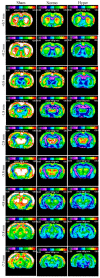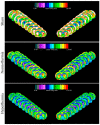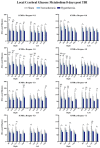Mild Hyperthermia Aggravates Glucose Metabolic Consequences in Repetitive Concussion
- PMID: 31963504
- PMCID: PMC7013838
- DOI: 10.3390/ijms21020609
Mild Hyperthermia Aggravates Glucose Metabolic Consequences in Repetitive Concussion
Abstract
Traumatic brain injury (TBI) is one of the leading causes of mortality and disability around the world. Mild TBI (mTBI) makes up approximately 80% of reported cases and often results in transient psychological abnormalities and cognitive disruption. At-risk populations for mTBI include athletes and other active individuals who may sustain repetitive concussive injury during periods of exercise and exertion when core temperatures are elevated. Previous studies have emphasized the impact that increased brain temperature has on adverse neurological outcomes. A lack of diagnostic tools to assess concussive mTBI limits the ability to effectively identify the post-concussive period during which the brain is uniquely susceptible to damage upon sustaining additional injury. Studies have suggested that a temporal window of increased vulnerability that exists corresponds to a period of injury-induced depression of cerebral glucose metabolism. In the current study, we sought to evaluate the relationship between repetitive concussion, local cerebral glucose metabolism, and brain temperature using the Marmarou weight drop model to generate mTBI. Animals were injured three consecutive times over a period of 7 days while exposed to either normothermic or hyperthermic temperatures for 15 min prior to and 1 h post each injury. A 14C-2-deoxy-d-glucose (2DG) autoradiography was used to measure local cerebral metabolic rate of glucose (lCMRGlc) in 10 diverse brain regions across nine bregma levels 8 days after the initial insult. We found that repetitive mTBI significantly decreased glucose utilization bilaterally in several cortical areas, such as the cingulate, visual, motor, and retrosplenial cortices, as well as in subcortical areas, including the caudate putamen and striatum, compared to sham control animals. lCMRGlc was significant in both normothermic and hyperthermic repetitive mTBI animals relative to the sham group, but to a greater degree when exposed to hyperthermic conditions. Taken together, we report significant injury-induced glucose hypometabolism after repetitive concussion in the brain, and additionally highlight the importance of temperature management in the acute period after brain injury.
Keywords: 2DG; concussion; glucose metabolism; hyperthermia; mild TBI; repetitive concussion; traumatic brain injury.
Conflict of interest statement
The authors declare no conflicts of interest.
Figures




Similar articles
-
Emergence of cognitive deficits after mild traumatic brain injury due to hyperthermia.Exp Neurol. 2015 Jan;263:254-62. doi: 10.1016/j.expneurol.2014.10.020. Epub 2014 Oct 29. Exp Neurol. 2015. PMID: 25447938 Free PMC article.
-
Mild hyperthermia worsens the neuropathological damage associated with mild traumatic brain injury in rats.J Neurotrauma. 2012 Jan 20;29(2):313-21. doi: 10.1089/neu.2011.2152. J Neurotrauma. 2012. PMID: 22026555 Free PMC article.
-
Brain hyperthermia alters local cerebral glucose utilization: a comparison of hyperthermic agents.Int J Hyperthermia. 1997 Jan-Feb;13(1):99-114. doi: 10.3109/02656739709056434. Int J Hyperthermia. 1997. PMID: 9024931
-
[Mild traumatic brain injury and postconcussive syndrome: a re-emergent questioning].Encephale. 2012 Sep;38(4):329-35. doi: 10.1016/j.encep.2011.07.003. Epub 2011 Aug 31. Encephale. 2012. PMID: 22980474 Review. French.
-
Is temperature an important variable in recovery after mild traumatic brain injury?F1000Res. 2017 Nov 20;6:2031. doi: 10.12688/f1000research.12025.1. eCollection 2017. F1000Res. 2017. PMID: 29188026 Free PMC article. Review.
Cited by
-
Multimodal magnetic resonance imaging of youth sport-related concussion reveals acute changes in the cerebellum, basal ganglia, and corpus callosum that resolve with recovery.Front Hum Neurosci. 2022 Oct 19;16:976013. doi: 10.3389/fnhum.2022.976013. eCollection 2022. Front Hum Neurosci. 2022. PMID: 36337852 Free PMC article.
-
Multimodal magnetic resonance imaging after experimental moderate and severe traumatic brain injury: A longitudinal correlative assessment of structural and cerebral blood flow changes.PLoS One. 2023 Aug 7;18(8):e0289786. doi: 10.1371/journal.pone.0289786. eCollection 2023. PLoS One. 2023. PMID: 37549175 Free PMC article.
-
Conservative Management of Acute Sports-Related Concussions: A Narrative Review.Healthcare (Basel). 2024 Jan 23;12(3):289. doi: 10.3390/healthcare12030289. Healthcare (Basel). 2024. PMID: 38338173 Free PMC article. Review.
-
A review on targeted temperature management for cardiac arrest and traumatic brain injury.Front Neurosci. 2024 Oct 31;18:1397300. doi: 10.3389/fnins.2024.1397300. eCollection 2024. Front Neurosci. 2024. PMID: 39544908 Free PMC article. Review.
-
Heat acclimation defense against exertional heat stroke by improving the function of preoptic TRPV1 neurons.Theranostics. 2025 Jan 1;15(4):1376-1398. doi: 10.7150/thno.101422. eCollection 2025. Theranostics. 2025. PMID: 39816678 Free PMC article.
References
-
- Faul M., Xu L., Wald M.M., Coronado V.G. Traumatic Brain Injury in the United States: Emergency Department Visits, Hospitalizations and Deaths 2002–2006. Centers for Disease Control and Prevention, National Center for Injury Prevention and Control; Atlanta, GA, USA: 2010.
-
- Coronado V.G., Thurman D.J., Greenspan A.I., Weissman B.M. Epidemiology. In: Jallo J., Loftus C.M., editors. Neurotrauma and Critical Care of the Brain. Thieme; New York, NY, USA: 2009.
MeSH terms
Substances
Grants and funding
LinkOut - more resources
Full Text Sources
Medical

